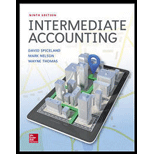
Concept explainers
• LO18–5
At December 31, 2017, the
| Shareholders’ Equity | ($ in millions) |
| Common stock, 60 million shares at $1 par | $ 60 |
| Paid-in capital—excess of par | 300 |
| 410 |
Required:
Assuming that Meca International views its share buybacks as treasury stock, record the appropriate
1. On February 12, 2018, Meca reacquired 1 million common shares at $13 per share.
2. On June 9, 2019, Meca reacquired 2 million common shares at $10 per share.
3. On May 25, 2020, Meca sold 2 million treasury shares at $15 per share. Determine cost as the weighted-average cost of treasury shares.
4. For the previous transaction, assume Meca determines the cost of treasury shares by the FIFO method.
Treasury Stock: It refers to the shares that are reacquired by the corporation that are already issued to the stockholders, but reacquisition does not signify retirement.
To Journalize: The treasury stock transactions for M International.
Explanation of Solution
(1)
Journalize the shares required (reacquired as treasury stock) on February 12, 2018.
| Date | Account Titles and Explanation | Post Ref. | Debit ($) | Credit ($) | |
| 2018 | |||||
| February | 12 | Treasury Stock | 13,000,000 | ||
| Cash | 13,000,000 | ||||
| (To record purchase of treasury stock) | |||||
Table (1)
- Treasury Stock is stockholders’ equity account. The amount has decreased because common stock is purchased as treasury stock. Therefore, debit Treasury Stock account with $13,000,000.
- Cash is an asset account and the amount is decreased because cash is paid to buy treasury stock. Therefore, credit Cash account with $13,000,000.
Working Note:
Compute the treasury stock amount.
(2)
Journalize the shares required (reacquired as treasury stock) on June 9, 2019.
| Date | Account Titles and Explanation | Post Ref. | Debit ($) | Credit ($) | |
| 2019 | |||||
| June | 9 | Treasury Stock | 20,000,000 | ||
| Cash | 20,000,000 | ||||
| (To record purchase of treasury stock) | |||||
Table (2)
- Treasury Stock is stockholders’ equity account. The amount has decreased because common stock is purchased as treasury stock. Therefore, debit Treasury Stock account with $20,000,000.
- Cash is an asset account and the amount is decreased because cash is paid to buy treasury stock. Therefore, credit Cash account with $20,000,000.
Working Note:
Compute the treasury stock amount.
(3)
Journalize the sale of treasury stock on May 25, 2020 (Use weighted average cost method to determine the cost of treasury stock).
| Date | Account Titles and Explanation | Post Ref. | Debit ($) | Credit ($) | |
| 2020 | |||||
| May | 25 | Cash | 30,000,000 | ||
| Treasury Stock | 22,000,000 | ||||
Paid-in Capital–Share Repurchase |
8,000,000 | ||||
| (To record sale of treasury stock) | |||||
Table (3)
- Cash is asset account. The amount is increased because cash is received on sale of treasury stock. Therefore, debit Cash account with $30,000,000.
- Treasury Stock is a stockholders’ equity account and the equity amount has increased due to sale of treasury stock. Therefore, credit Treasury Stock account with $22,000,000.
- Paid-in Capital–Share Repurchase is a stockholders’ equity account and the amount has increased because treasury stock is sold for more than the price purchased. Therefore, credit Paid-in Capital–Share Repurchase account with $8,000,000.
Working Notes:
Compute cash received.
Compute treasury stock at weighted average cost.
Note: Refer to transactions 1 and 2 for values and computations of treasury stock amount and number of treasury shares.
Compute treasury stock value.
Note: Refer to Equation (2) for value and computation of weighted average cost of treasury shares.
Compute paid-in capital–share repurchase value.
Note: Refer to Equations (1) and (3) for the values and computations of cash received and treasury stock value at cost.
(4)
Journalize the sale of treasury stock on May 25, 2020 (Use FIFO method to determine the cost of treasury stock).
| Date | Account Titles and Explanation | Post Ref. | Debit ($) | Credit ($) | |
| 2020 | |||||
| May | 25 | Cash | 30,000,000 | ||
| Treasury Stock | 23,000,000 | ||||
Paid-in Capital–Share Repurchase |
7,000,000 | ||||
| (To record sale of treasury stock) | |||||
Table (4)
- Cash is asset account. The amount is increased because cash is received on sale of treasury stock. Therefore, debit Cash account with $30,000,000.
- Treasury Stock is a stockholders’ equity account and the equity amount has increased due to sale of treasury stock. Therefore, credit Treasury Stock account with $23,000,000.
- Paid-in Capital–Share Repurchase is a stockholders’ equity account and the amount has increased because treasury stock is sold for more than the price purchased. Therefore, credit Paid-in Capital–Share Repurchase account with $7,000,000.
Working Notes:
Compute cash received.
Compute treasury stock at first-in-first-out (FIFO) cost for first 1,000,000 shares.
Compute treasury stock at first-in-first-out (FIFO) cost for next 1,000,000 shares.
Compute total treasury stock value.
Note: Refer to Equations (5) and (6) for values and computations of treasury stock value for first 1,000,000 shares and treasury stock value for next 1,000,000 shares.
Compute paid-in capital–share repurchase value.
Note: Refer to Equations (4) and (7) for the values and computations of cash received and treasury stock value at cost.
Want to see more full solutions like this?
Chapter 18 Solutions
INTERMEDIATE ACCOUNTING (LL) W/CONNECT
- On May 31, 2026, Oriole Company paid $3,290,000 to acquire all of the common stock of Pharoah Corporation, which became a division of Oriole. Pharoah reported the following balance sheet at the time of the acquisition: Current assets $846,000 Current liabilities $564,000 Noncurrent assets 2,538,000 Long-term liabilities 470,000 Stockholder's equity 2,350,000 Total assets $3,384,000 Total liabilities and stockholder's equity $3,384,000 It was determined at the date of the purchase that the fair value of the identifiable net assets of Pharoah was $2,914,000. At December 31, 2026, Pharoah reports the following balance sheet information: Current assets $752,000 Noncurrent assets (including goodwill recognized in purchase) 2,256,000 Current liabilities (658,000) Long-term liabilities (470,000) Net assets $1,880,000 It is determined that the fair value of the Pharoah division is $2,068,000.arrow_forwardOn May 31, 2026, Oriole Company paid $3,290,000 to acquire all of the common stock of Pharoah Corporation, which became a division of Oriole. Pharoah reported the following balance sheet at the time of the acquisition: Current assets $846,000 Current liabilities $564,000 Noncurrent assets 2,538,000 Long-term liabilities 470,000 Stockholder's equity 2,350,000 Total assets $3,384,000 Total liabilities and stockholder's equity $3,384,000 It was determined at the date of the purchase that the fair value of the identifiable net assets of Pharoah was $2,914,000. At December 31, 2026, Pharoah reports the following balance sheet information: Current assets $752,000 Noncurrent assets (including goodwill recognized in purchase) 2,256,000 Current liabilities (658,000) Long-term liabilities (470,000) Net assets $1,880,000 It is determined that the fair value of the Pharoah division is $2,068,000.arrow_forwardThe following transactions involving intangible assets of Oriole Corporation occurred on or near December 31, 2025. 1.) Oriole paid Grand Company $520,000 for the exclusive right to market a particular product, using the Grand name and logo in promotional material. The franchise runs for as long as Oriole is in business. 2.) Oriole spent $654,000 developing a new manufacturing process. It has applied for a patent, and it believes that its application will be successful. 3.) In January 2026, Oriole's application for a patent (#2 above) was granted. Legal and registration costs incurred were $247,800. The patent runs for 20 years. The manufacturing process will be useful to Oriole for 10 years. 4.) Oriole incurred $168,000 in successfully defending one of its patents in an infringement suit. The patent expires during December 2029. 5.) Oriole incurred $446,400 in an unsuccessful patent defense. As a result of the adverse verdict, the patent, with a remaining unamortized cost of…arrow_forward
- Reffering to fair value of an asset, division, or organization, What exactly is fair value and how is it assessed?arrow_forwardThe following transactions involving intangible assets of Oriole Corporation occurred on or near December 31, 2025. 1.) Oriole paid Grand Company $520,000 for the exclusive right to market a particular product, using the Grand name and logo in promotional material. The franchise runs for as long as Oriole is in business. 2.) Oriole spent $654,000 developing a new manufacturing process. It has applied for a patent, and it believes that its application will be successful. 3.) In January 2026, Oriole's application for a patent (#2 above) was granted. Legal and registration costs incurred were $247,800. The patent runs for 20 years. The manufacturing process will be useful to Oriole for 10 years. 4.) Oriole incurred $168,000 in successfully defending one of its patents in an infringement suit. The patent expires during December 2029. Oriole incurred 5.) $446,400 in an unsuccessful patent defense. As a result of the adverse verdict, the patent, with a remaining unamortized cost of…arrow_forwardNonearrow_forward
- I need help solving this general accounting question with the proper methodology.arrow_forwardI need help with this general accounting question using the proper accounting approach.arrow_forwardPlease provide the correct answer to this general accounting problem using valid calculations.arrow_forward
 Cornerstones of Financial AccountingAccountingISBN:9781337690881Author:Jay Rich, Jeff JonesPublisher:Cengage Learning
Cornerstones of Financial AccountingAccountingISBN:9781337690881Author:Jay Rich, Jeff JonesPublisher:Cengage Learning Accounting (Text Only)AccountingISBN:9781285743615Author:Carl Warren, James M. Reeve, Jonathan DuchacPublisher:Cengage Learning
Accounting (Text Only)AccountingISBN:9781285743615Author:Carl Warren, James M. Reeve, Jonathan DuchacPublisher:Cengage Learning

